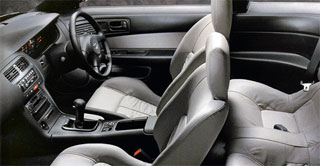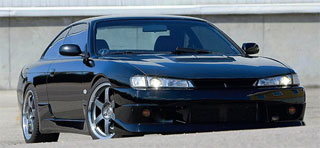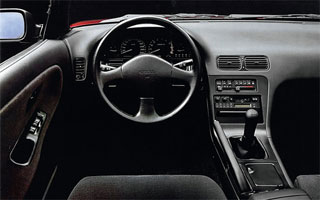Test drive Nissan 240SX 1994 - 1998
Sweet flight
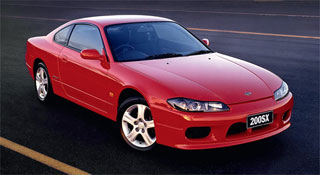 In addition to the concept of vegetables known to motorists, there is another, less common fruit, that is, a car that is taken for a walk only on warm days. And Nissan 200sx/Silvia fans nicknamed their favorite with plum.
In addition to the concept of vegetables known to motorists, there is another, less common fruit, that is, a car that is taken for a walk only on warm days. And Nissan 200sx/Silvia fans nicknamed their favorite with plum. People buy cult Japanese cars such as Toyota Supra, Subaru WRX STI, Mitsubishi Lancer Evolution, Nissan Skyline, Mazda RX7 and especially Nissan 200SX/Silvia (we intend to clean the bones), guided by many reasons, including relative and expressive design. , excellent high -speed possibilities, a sea of \u200b\u200binexpensive tuning, great potential for further refinement but especially owners attract insignificant costs for the content of these models. For example, high -speed German machines are very expensive to operate: these are by no means cheap spare parts, and feud. Therefore, such cars are the choice of wealthy buyers who are ready to invest decent money not only in improving the working characteristics, but also simply to serve their favorites. Japanese machines can save more means for tuning.
Nissan 200SX/Silvia with the factory index S14 (19931998), albeit unpretentious, but very beautiful, and its beauty is special, full of strength and confidence. A sort of quintessence of Japanese sportsmen from the category of Old-Skul, no less. The model with the S15 index (unfortunately, the rarest phenomenon on our roads) also delights, but rather Italian grace, sensual and lively aesthetics, and not rude engineering. Be that as it may, any drain of a real compartment with a separate trunk, unlike many other Japanese races, which are hatchbacks that pretend to be a compartment. Potential buyers of used cars (and there are no others) must probably please that these cars practically do not have problems with electricity and body. Of course, provided that they are unbearable, and Silvia, which did not visit the accident, is more likely an exception than the rule.
Characteristics Silvia S14
Body
compartment
Stream doors
2
Summer places
4
Length
4520 mm
Width
1730 mm
Height
1295 mm
Wheelbase
2525 mm
Ground clearance
130 mm
Suspension:
Front
The back
independent, with racks like MacPherson
independent, multi -link
Drive unit
rear
Brakes:
Front
rear
disk ventilated
disk
The volume of the gas tank
65 l
Max. speed
180 km/h (limited by electronics)
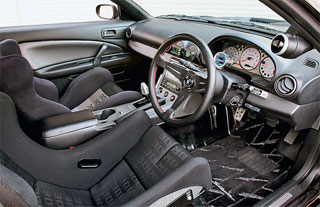 Silvia’s salon is typical of a sports car of this format: it is cramped (which, in principle, is not shameful: it is not about the family machine), is decorated with inexpensive, but quite high-quality plastic, outwardly quite ascetic. No, the Japanese did not feel true, they simply created the right atmosphere. In such a sports car there is no place for glamor, each button is in its place, the seat fixes the driver well in corners so that he breathes in the same rhythm with the car. The entire interior is saturated with a sports spirit. Well, with unimportant sound insulation you can come to terms, especially since the machine is equipped in full.
Silvia’s salon is typical of a sports car of this format: it is cramped (which, in principle, is not shameful: it is not about the family machine), is decorated with inexpensive, but quite high-quality plastic, outwardly quite ascetic. No, the Japanese did not feel true, they simply created the right atmosphere. In such a sports car there is no place for glamor, each button is in its place, the seat fixes the driver well in corners so that he breathes in the same rhythm with the car. The entire interior is saturated with a sports spirit. Well, with unimportant sound insulation you can come to terms, especially since the machine is equipped in full. The longitudinal dynamics, even with an atmospheric engine, Silvia has quite worthy, as the Americans say, she is able to get out of her own path. And it slows down well. Acceleration with the turbo engine is excellent, especially if they managed to conjure with the latter: the unit is dashing, easily climbing into the zone unattainable revolutions for ordinary engines. The controllability, unfortunately, does not inspire: clear, unambiguous, but with some lazy. However, such cars are very fond of drift in the world, and there, as you know, they value cars that forgive mistakes, and not punish them. And Silvia, thanks to a low turning point around the central axis, is just like that.
The only engine installed on Silvia/200SX, SR20 in different variations (atmospheric SR20DE with a capacity of 165 liters, as well as a 220-horsepower SR20DET with turbocharged). The low at first glance, the return on the turbo engine is mainly due to the fact that the machine from the plant is noticeably strangled. Therefore, when buying the first thing (in addition to a thorough revision, of course), it is worth taking care of the replacement of the standard exhaust, as well as the installation of a new intercooler in the place of a standard unit in front of the front left wheel. It would seem that there are few stock Silvia on the roads, but for the sale, oddly enough, plums are more often put up in this form (before parting, the owners undress them, so that all additional equipment is sold separately). Therefore, it is advisable to lay a certain amount in the estimate, at least for minimal support. Some wealthy motorists, by the way, go even further: they install new turbines and select the necessary components under them, bringing power to 500 liters. With. and more. At the same time, even such engines feel good (SR20DET margins are impressive, allows you to remove considerable power with great run). Provided, of course, what was followed by the motor. It is impossible to neglect the service under any circumstances, and since the owners of the drain do not miss the opportunity to squeeze gas to failure, they scrupulously relate to that their horses, conducting it with the replacement of oil and all filters every 710 thousand km, or even more often. I must say, this option is much more attractive than Silvia from a pensioner who has never launched an engine higher than 2500 rpm in his life, but the oil also changed 2030 thousand km after a run.
In addition to scheduled services, there are no other worries: money mainly goes to tuning. It is unlikely that you will have to even change candles more often than after 60 thousand km (if you refuel with good gasoline by the standards of our country), and you can not look at the gas distribution mechanism for a long time instead of the belt there.
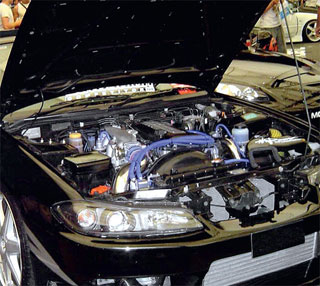 The gearboxes are quite reliable, both machine guns and mechanics. The former require quite frequent maintenance (oil replacement every 4060 thousand km), and indeed, automatic transmission in a sports car is inappropriate. Enthusiasts choose mechanics (especially mentioned drift lovers). Problems with manual transmission arise very rarely. Even if a sadist is sitting at the wheel, he will go mainly to replace the clutch, to which the designers assigned the role of a weak link, entrusting the protection of the box from the bullying of the reckless drivers.
The gearboxes are quite reliable, both machine guns and mechanics. The former require quite frequent maintenance (oil replacement every 4060 thousand km), and indeed, automatic transmission in a sports car is inappropriate. Enthusiasts choose mechanics (especially mentioned drift lovers). Problems with manual transmission arise very rarely. Even if a sadist is sitting at the wheel, he will go mainly to replace the clutch, to which the designers assigned the role of a weak link, entrusting the protection of the box from the bullying of the reckless drivers. The claims are minimal to the suspension: from time to time, shock absorbers and racks of pine stability stabilizers will have to be changed (shock absorbers go 100 thousand km, and this is not enough). With regular operation, levers almost never change. Another thing, runs of such cars are usually small, and in winter they usually stand in garages in anticipation of the season
An excellent car, but unpopular: in Russia, only one (!) 200sx was officially sold in Russia, the rest of the plums, which were knitting along the domestic roads, came to us from Europe and Japan. The fact is that the Japanese compartment is an impractical thing. Yes, and the content is not cheap: self -respecting Silvia owner prefers to purchase either original spare parts (they are extremely expensive and taken mainly to order), or tuning (of which, perhaps, you can build a car from scratch, so there are a lot of them on the market). But such a car cannot be called a reasonable acquisition. It is bought either out of love for high speed and shocking, or as an image means of transportation with good speed potential, or as a solid workpiece for a dizzying tuning project. Cars from the latest category among Russian (and not only) Silvia very, very much
The advantages and disadvantages of the model
Advantages
beauty, huge potential for tuning, decent level of reliability
Flaws
high prices for used cars, inexpensive salon, low comfort level
Approximate price order in Moscow, rub.:
250 thousand (Silvia S14 1994, SR20DE, stock);
300 thousand (Silvia S15 1999, SR20DE, stock);
400 thousand (Silvia S15 2002, SR20DE, stock);
500 thousand (Silvia S15 1999, SR20Det, stock);
700 thousand (Silvia Varietta Cabriolet 2001, SR20DE, Stock);
750 thousand (Silvia S15 1999, SR20Det, tuning);
1, 5 million (Silvia S14 1996, SR20Det, serious tuning).
